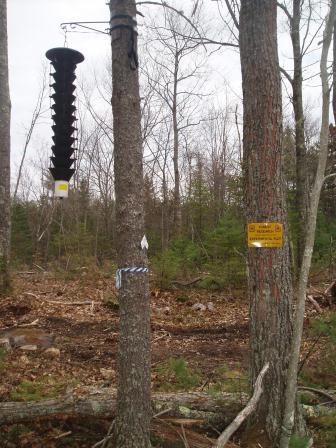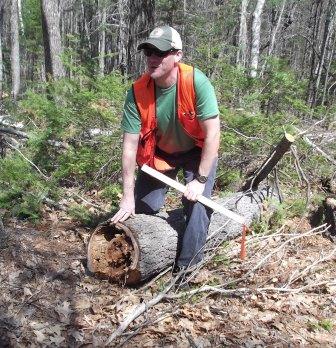Neighbors, hikers, and casual visitors to Mount Grace's Paul C. Dunn Woodland Preserve in Ashburnham are all asking the same question...What are those things?
Stewardship: Paul Dunn Beetle Survey
Neighbors, hikers, and casual visitors to the Paul C. Dunn Woodland Preserve are all asking the same question...What are those things?
Twenty black plastic inverted towers are hanging among the pine and maple trees that cover the uplands of the Ashburnham preserve, donated to Mount Grace in 1991 to be a forest management demonstration area.
Mount Grace is now working with entomologists from the USDA Forest Service Northern Research Station to examine tree death and wildlife use of trees killed by native beetles. The mysterious black objects that have inspired so much curiosity are insect traps. We are looking for native insect species that exist symbiotically with the forest, not any of the invasive species that are grabbing headlines around the commonwealth.
Lately much of the attention has been on how invasive insects like the Asian Long Horned Beetle potentially threaten Massachusetts forests. Yet native insects play a very important role in forest ecosystems by providing food for numerous other species.
Trees killed by native insects perform an important function even in death. Standing dead trees, “snags,” provide nesting places for animals like pileated woodpeckers, barred owls, and flying squirrels. The bigger the snag, the larger the animals that stay there; even bears will den in dead trees if the tree is large enough.
The mature old-growth forests that were here 400 years ago are estimated to have contained at least four snags greater than 12 inches in diameter per acre. Today, southern New England’s forests are usually less than a century old and often average less than one 12 inch+ snag per acre. Land stewards concerned with biodiversity look for ways to increase the number of large snags. Native insects may be one answer.
Paul Dunn conservation area was chosen for this experiment because of the recent timber harvest which created ideal conditions to attract beneficial native wood boring insects. As trees and branches decay they release chemicals that attract these insects. Dead wood left in the harvest area releases a massive amount of these chemicals, attracting a robust insect population which will help break down the dead wood and provide food for other species, while leaving the surrounding healthy trees unaffected. Its nature’s way of never letting anything go to waste.
Normally, native wood boring insects occur in low densities but a disturbance like a tornado or a timber harvest which leaves a lot of downed wood acts like a dinner bell and insects rush in to take advantage. It is these high insect densities that the research project wishes to capitalize on.
Mount Grace and the Forest Service chose 40 experimental trees: 20 White Pines and 20 Red Maples, all with a diameter of 12 inches or more. Our goal is to attract large numbers of insects to these trees in hopes that enough of them will burrow into the tree to kill it and form a snag. Because these are live trees and the insects are attracted to dead and dying trees, we placed pheromone lures on half of the experimental trees while the rest were left as the control group.
Every two weeks from April through October we will look at the number and types of insects in the traps and measure tree health by checking water stress and chlorophyll levels. Later in the summer we will begin collecting data on woodpecker excavations and cavities in the trees. Because woodpecker cavities are used by many different animals, this information, collected annually, will serve as an index of overall wildlife habitat suitability.
This research will help to answer three overarching questions: can the use of insect pheromone lures in recent timber harvest areas help to create snags; what are the physiological effects on a tree that succumbs to wood boring insects and; what is the response of woodpeckers to trees baited with pheromone lures?
If the results of this study are significant, Mount Grace and the Forest Service will have identified an effective and inexpensive method to create one of the most important forest wildlife habitat types (a snag) that may become an integral tool of forest stewardship. As we like to say “There’s life in dead wood”


